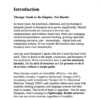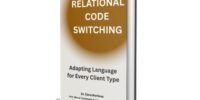Description
EM-Focus
The Therapist’s Map for Emotion-Driven Change
Every therapist knows the feeling:
You’re deep in session with a client who’s overwhelmed by intense emotions—sadness, anger, shame—and you want to help them process it meaningfully.
But where do you start?
How do you stay grounded while guiding emotional exploration without getting swept up yourself?
Many clinicians struggle with this balance:
- How to contain emotional intensity without shutting it down
- How to guide clients toward insight and action , rather than just venting
- How to maintain clarity and direction , even when emotions feel messy or chaotic
This is where many emotion-focused approaches fall short — they emphasize depth, but lack structure. And without structure, therapy can become reactive, unfocused, or exhausting.
The Solution: EM-Focus
EM-Focus: The Therapist’s Map for Emotion-Driven Change gives you a clear, practical framework to bring structure to emotional work so you can guide clients safely and effectively through difficult feelings without losing clinical focus.
With its 3-step model, EM-Focus helps you:
- Name and validate the emotion-building safety and self-awareness
- Explore deeper meaning, uncovering patterns, themes, and stuck points
- Support micro-actions turning insight into small but powerful steps forward
Whether you’re working with trauma, attachment wounds, anxiety, or complex cases, EM-Focus integrates seamlessly into CBT, psychodynamic, somatic, or integrative approaches.
Equipped with real-life scripts, visual tools, worksheets, and session maps, this tool empowers you to navigate emotional terrain with confidence and help clients move from overwhelm to meaningful change.
 In the End, It’s About Confidence and Clarity
In the End, It’s About Confidence and Clarity
EM-Focus isn’t just another therapeutic model; it’s your compass for navigating emotional complexity with intention and skill.
It’s about showing up to every session not only as an empathetic listener but as a clear-headed guide, ready to support your clients through emotional depth without losing your own grounding.
Because when you have structure, you can go deeper safely, intentionally, and with purpose.











Dana B., CBT Practitioner –
The printable tools alone are worth the price — but the real magic is how the framework ties everything together.
Tina M., Trauma-Informed Therapist –
This book bridges emotional depth and structure perfectly. It’s a must-have for any therapist who feels stuck with client progress.
Dr. Nina S., Clinical Supervisor –
Simple. Elegant. Immediately useful. EM-Focus is the kind of book I wish I had during grad school.
Samuel T., Psychotherapist –
I used to spend too much time planning sessions. Now I follow the EM-Focus map and can actually be more present with my clients.
Olivia G., Psychodynamic Counselor –
I’m already recommending EM-Focus to my supervision group. It’s a new essential in my therapy toolkit.
Lucas J., LPC –
The micro-actions concept changed how I do therapy. Small, consistent steps are now part of every session — and clients are responding.
Dr. Melanie Rhodes, Clinical Psychologist –
Finally, a framework that simplifies emotional work without oversimplifying the client. EM-Focus is clear, usable, and powerful.
Ava L., Licensed Mental Health Counselor –
The structure helped me feel less scattered in session. My clients are actually moving forward with micro-actions — and they love it.
Samantha C.., Licensed Mental Health Psychotherapist –
I’ve read dozens of therapy books. This one stood out for how instantly applicable it was. I used the Emotion Wheel worksheet the same day.
Karen D., MFT –
EM-Focus gave me a renewed sense of confidence, especially with clients who struggle to verbalize their emotions. It just works.